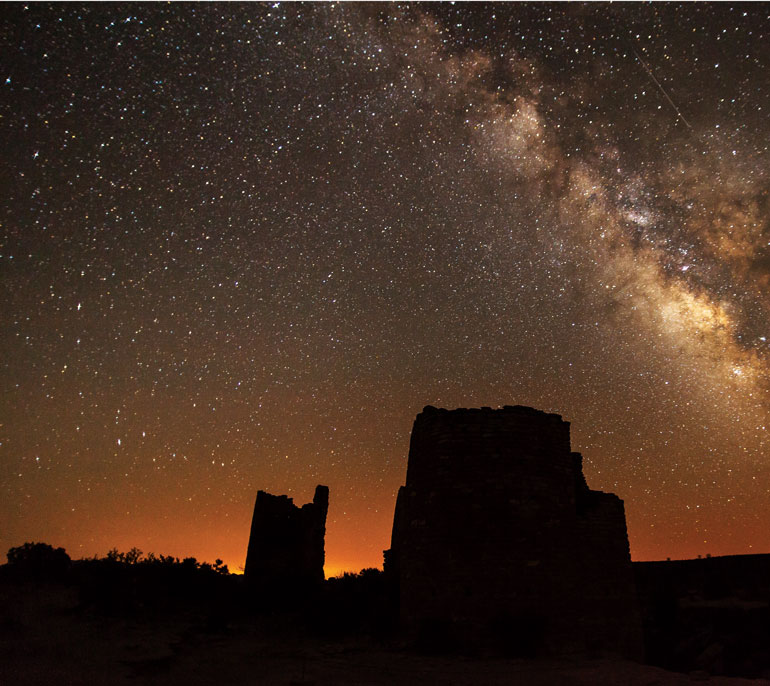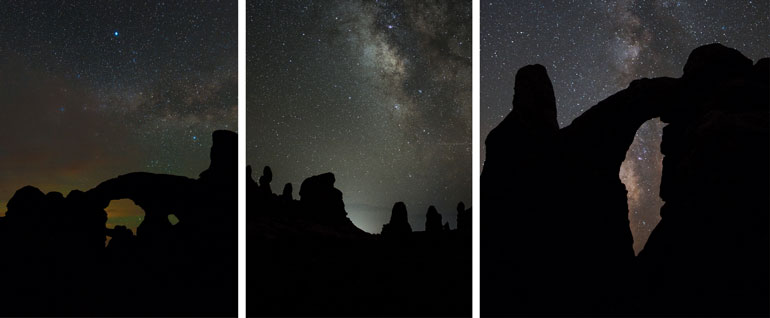How to find the best nighttime skies in Utah
Before man-made technologies captured our gaze, a celestial bond existed between all people.

Stargazing today isn’t what it once was, back when our forebears gazed up at the night skies, named the stars and told stories about them. With our modern light-drenched skies, it’s hard to imagine worshiping stars much less navigating by them. Even in Salt Lake City, nighttime light pollution scores at the top of the Bortle Dark Sky Scale—class 8 out of a 9-point scale.
For those wanting to see constellations, that’s bad news. On moonless nights, the sky, as seen from our city, never quite achieves true darkness. Instead, the reflection of street lamps and security lights creates a grayish-white glow, making clouds appear lit from below. It’s easier to read a newspaper headline while standing outdoors than to find even a constellation as bright and recognizable as Orion.
If the absence of a night sky makes you as sad as it does me, you’ll be relieved to learn that despite Salt Lake City’s disappointing light-pollution ranking, other places in Utah offer some of the best nighttime viewing in the world. And you don’t have to travel very far to get a gander at those heavenly bodies.
In April, Antelope Island State Park, just an hour’s drive north of the capital city, became the ninth Utah site recognized for its “exceptional starry nights” by the International Dark Sky Association. Utah now has more dark sky designations than any other state, province or region in the world.
Orion rising
And this brings me back to my favorite autumn/winter constellation: Orion. We all have our reasons for wanting to see the stars. For me, the coolest thing about a lively night sky is the way it opens doors to all sorts of ancient stories from around the world.
The bright stars of Orion have attracted the attention of stargazers from Australia—where Orion’s belt is called the Pot or Saucepan—to South Africa, where his tri-starred belt is known as the Three Kings or the Three Sisters. The ancient Babylonians knew Orion as the Heavenly Shepherd and associated the star cluster with their god Anu. Meanwhile, the ancient Egyptians believed that the constellation was linked with Osiris, the god of death, afterlife and rebirth.
Orion, as we know him, is named for the handsome hunter and demi-god of Greek mythology, son of the sea god Poseidon and the Cretan princess Euryale. Though he is known by many names around the world, the Greeks weren’t the only ones to associate this particular star cluster with hunters and a warriors.
In Hungarian mythology, he is called Nimrod, to the Chinese he is Shen, and to the ancient Hittites of Anatolia he was Aqhat. It’s incredible that, despite our differences, and the vast distances that separated ancient humans, we all saw something similar when we looked heavenward.
If looking at the stars with your eyes alone doesn’t inspire the kind of awe that the ancients felt, try looking at the stars through a telescope (or binoculars; they aren’t nearly as good as a telescope but can reveal far more than is possible to view with the unaided eye).
Don’t have a telescope? The (Salt Lake Astronomical Society hosts star parties each month at locations around the city (including Wheeler Farm and Harmons Emigration Market). Star parties are open to the public; volunteers set up and train their telescopes on the heavens for all to enjoy. A little farther away, you can enjoy an even better view at the Stansbury Park Observatory Complex just north of Tooele (252 UT-138, Stansbury Park). Look for Saturday meet-up dates on the SLAS website’s calendar of events.
To a catch a glimpse of the stars at our newest Dark Sky park, join the Ogden Astronomical Society at one of its monthly Saturday star parties hosted at Antelope Island State Park (parties start at 6 p.m. but the weeks vary, so check the organization’s website for exact dates). With a little magnification, those distant suns, often just specks in the sky, will be transformed.
PHOTOS BY NEAL HERBERT & JACOB FRANK, NATIONAL PARK SERVICE




